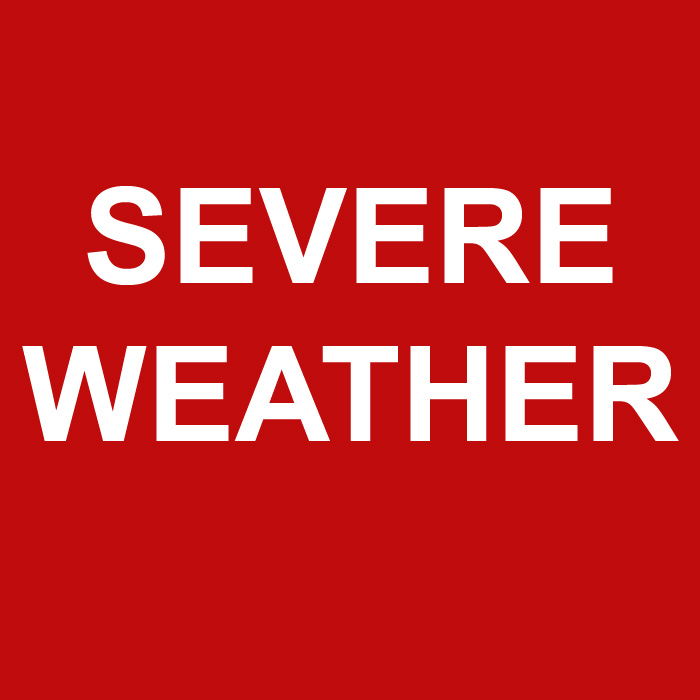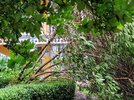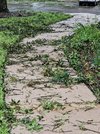Maybe I am niave when it comes to hurricanes, but for me the focus was always on the wind speed.. maybe because I am used to tornados.. And on the TV screens all you really saw was the wind as this makes it a CAT 4 vs 5 so more newsworthly. So I wonder if locals focus more on the "strengh" wind vs. potential flooding??? maybe that is why many didnt leave as the focus was on wind.. thinking okay my house is hurricane built so i'll be ok. The news did report on expected water surge but more focuson wind vs. water in reporting.. until it happens then there is the water reporting. knwim?
Sensationalism.
It really all boils down to 'scale'. Like a tornado... incredibly destructive, but also incredibly focused. One spot can tear a brick building down, while 100ft to the side can just get some dirt damage.
Wind
Hurricane Winds are incredibly strong, but only in a small portion of the total storm coverage. The vast majority of the storm gets like 40-50mph winds which you can see during any typical strong thunderstorm. The difference is the duration, so weak structures can degrade during the sustained onslaught. But short of debris damage, these kinds of winds are not really a major threat to modern construction, especially in an area built for it. The main damage is typically downed trees which get weakened with saturated ground. Other damage picked up tends to not be catastrophic, just property damage.
The main risk for wind is the high 100+mph winds that the storm carries near its core. These winds can be destructive to structures, and unlike a tornado, these winds will impact a sizable area for a sustained period of time. But while a major storm like this can live on for almost a week, these destructive winds die off very quickly once a storm is over land and fight real obstructions and not just warm water feeding it. So these major risk winds tend to only be a risk in the 50-100ish mile area around where the storm initially hits. So wind damage can happen anywhere along the storm's path, but real disaster level wind damage is really only a major risk in the immediate area where the storm first comes ashore. Most cat 1-3 storms weaken so quickly the wind risk is really only in the first 6-10hrs or so. (hitting islands is different, because the storms tend to recover and rebuild after passing over a small island).
Surge
Storm surge is a topic that really is about the intersection of vulnerability and scale. Areas can see tidal surges of 3-4 feet almost anytime.. or local rains can bring rivers up 3-6ft etc depending on the locale. As long as the area is used to that kind of water rise, it's really no big deal (disaster wise). Anyone who lives on the water with piers, houses, etc are used to the idea of unusually high surges from even regular storms that just happen to align the correct direction.
The problem become when the surge hits an area not tolerant of higher water (vulnerable) due to elevation or structure exposure to the waterfront OR the surge scale is so massive it will overwhelm the usual accommodations. The situation is exaggerated when water that gets past the shoreline can hang around or not drain back towards the open water due to low lying areas. This is how you see 'whole towns flooded' instead of just the first few blocks of ocean front. The flatter the area, the further water will typically make it inland.
The worst part of the storm surge in terms of height will be very localized to near the center of the storm where the wind and low pressure is the strongest. The leading edge exposed to the eastern side of the storm where the wind is pushing is also more at risk. So while a whole coastal area will see some storm surge, typically it's within normal kind of storm levels... its only some areas that face real severe levels and depending on their vulnerability, can be the difference between 'a town flooded' and 'most of a county' flooded.
Surge is more dangerous to both structures and people because it tends to be highly energetic and fast moving. So it will smash things, move cars, sweep people away, and tends to trap people who thought they were otherwise not at risk before. Storm surge is basically a mini tsunami in destruction.
Rain
Rain is the real factor that actually impacts large areas of a hurricane. Because it can be so high volume AND sustained AND over a large area. Increased development can hinder an area's ability to drain. Areas that are already prone to flooding due to land features are especially vulnerable due to the high rate and volume. Other low lying areas that may not be otherwise be flood prone due to nearby creeks/rivers can be at risk of standing water due to drainage.
Standing water flooding along with rivers overflowing are the main risks that even inland areas can face from a hurricane. They VERY rarely have to deal with much risk from wind or other factors. And standing water doesn't have nearly the danger factor that surge has because it's not usually swift water and it usually doesn't come up as quick.
Sustained rain can soften the ground so more trees fall and low lying areas can flood due to nowhere for the water to go.
This is why most people feel fine not evacuating for storms.
1) They know that the kind of damage they are facing tends to not be life threatening
2) They know the area to see the worst will be very localized - so 'its them, not me'
3) They believe they know their area's vulnerability/risk factors for flooding or surge exposure
The problems become when there are intersections of greater vulnerability combined with 'direct hit'. Because the 'direct hit' area is so small relatively, its pretty rare for the storms to 'hit that bullseye'. Stories like Katrina, Andrew,, and Harvey (Houston) are stories of direct hit + extreme strength + extending vulnerabilities.
For places like central FL - the biggest risk is extreme rain + a stalled system. Coastal towns have to fear direct hits for fear of storm surge and wind damage. But direct hits are pretty rare for most people's lifetimes.




